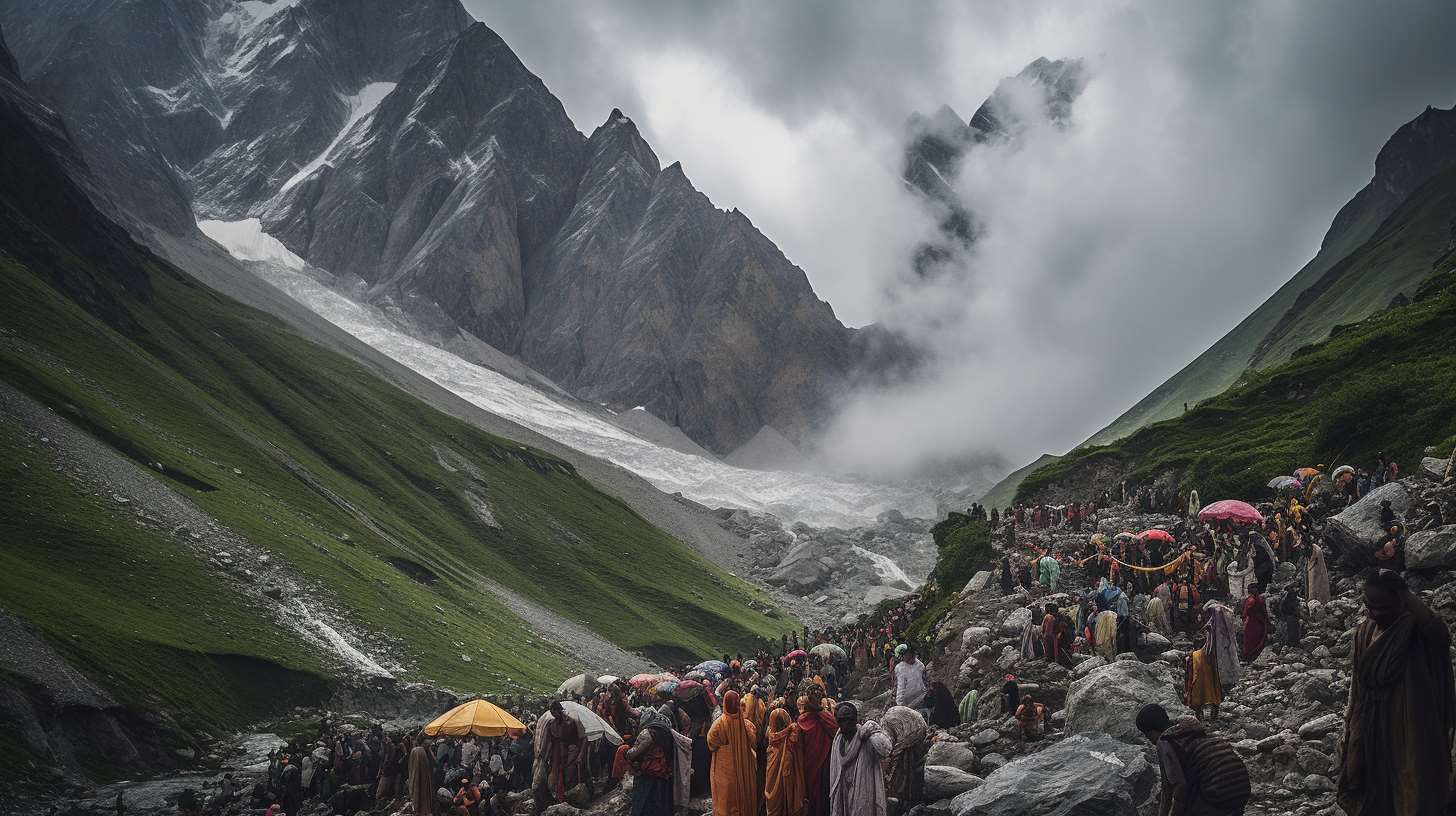The Amarnath pilgrimage, nestled in the majestic Himalayas of Jammu and Kashmir, stands as one of the most revered and challenging journeys for devout Hindus. Each year, thousands of pilgrims embark on this spiritual odyssey, seeking solace and divine blessings at the sacred Amarnath Cave.
Historical Significance of Amarnath
The historical roots of the Amarnath pilgrimage date back centuries, shrouded in myths, legends, and profound spirituality. It is believed that the cave holds immense significance in Hindu mythology, associated with Lord Shiva, the destroyer and transformer in the Hindu pantheon.
The Legend of Amarnath Cave
According to Hindu mythology, the Amarnath Cave is where Lord Shiva revealed the secrets of immortality to his consort, Parvati. Legend has it that the journey to the cave mirrors the journey of life and the pursuit of enlightenment.
Geography and Location of Amarnath
Located at an altitude of over 3,800 meters above sea level, the Amarnath Cave is nestled amidst the breathtaking snow-capped peaks of the Himalayas. Situated in the Anantnag district of Jammu and Kashmir, the cave remains accessible only during the summer months due to extreme weather conditions.
Accessibility and Transportation Options
Accessing the Amarnath Cave involves traversing rugged terrain and challenging landscapes. Pilgrims can reach the base camp by road or helicopter, with both options offering unique experiences and breathtaking views of the surrounding Himalayan landscape.
Weather Conditions and Best Time to Visit
The weather at Amarnath is highly unpredictable, with temperatures dropping below freezing even during the summer months. The best time to undertake the pilgrimage is from late June to early August when the weather is relatively mild and the cave is accessible.
Religious Rituals and Practices at Amarnath
The pilgrimage to Amarnath is not merely a physical journey but a spiritual quest filled with rituals, prayers, and devotional practices. Pilgrims undertake the arduous trek with unwavering faith, seeking blessings and divine intervention from Lord Shiva.
Safety and Security Measures for Pilgrims
Ensuring the safety and security of pilgrims is of paramount importance during the Amarnath Yatra. The government and local authorities implement stringent measures to safeguard pilgrims against natural disasters, avalanches, and other potential risks.
Accommodation and Facilities Available
Several temporary accommodations and facilities are set up along the pilgrimage route to cater to the needs of pilgrims. From tented camps to medical aid centers, every effort is made to ensure the comfort and well-being of pilgrims during their journey.
Cultural and Spiritual Experiences During the Pilgrimage
The Amarnath pilgrimage offers pilgrims a unique opportunity to immerse themselves in the rich tapestry of Indian culture and spirituality. From traditional rituals to soul-stirring hymns, every moment of the journey is infused with profound meaning and spiritual significance.
Challenges Faced by Pilgrims During the Journey
The journey to Amarnath is not without its challenges, both physical and spiritual. Pilgrims encounter treacherous terrain, inclement weather, and logistical hurdles along the way, testing their resilience and determination.
Importance of Amarnath Pilgrimage in Hinduism
The Amarnath pilgrimage holds immense significance in Hinduism, symbolizing the eternal cycle of life, death, and rebirth. It is a testament to the enduring faith of millions of devotees who undertake the journey in search of spiritual enlightenment and divine blessings.
Impact of Tourism on the Region
The influx of pilgrims and tourists to the Amarnath region has brought about significant economic and cultural changes. While tourism has provided livelihood opportunities for locals, it has also raised concerns about environmental degradation and conservation efforts.
Conservation Efforts and Environmental Concerns
Efforts are underway to mitigate the environmental impact of tourism on the fragile ecosystem of the Amarnath region. Sustainable practices, waste management initiatives, and awareness campaigns are being implemented to preserve the pristine beauty of the Himalayas for future generations.
Conclusion: Reflecting on the Spiritual Journey to Amarnath
The pilgrimage to Amarnath is more than just a physical journey; it is a soul-stirring odyssey that transcends boundaries and connects pilgrims to the divine. Amidst the rugged terrain and harsh conditions, pilgrims find solace, strength, and spiritual renewal, forging bonds of faith and devotion that endure beyond the confines of the pilgrimage.
FAQs
Is the Amarnath Cave accessible year-round?
The access to the cave is limited to the summer months, usually from late June to early August.
What are the main challenges faced by pilgrims during the journey?
Pilgrims encounter challenges such as treacherous terrain, inclement weather, and logistical hurdles during the journey to Amarnath.
How long does the Amarnath Yatra typically last?
The duration of the annual pilgrimage varies but typically spans around 45 days during the summer months.
Are there any age restrictions for pilgrims undertaking the Amarnath Yatra?
While there are no specific age restrictions, pilgrims are advised to undergo a medical check-up and consult their doctors before embarking on the journey.
What is the significance of the holy cave in Hindu mythology?
The Amarnath Cave is believed to be the place where Lord Shiva revealed the secrets of immortality to his consort, Parvati, making it a sacred site of immense spiritual significance in Hinduism.
Are there any medical facilities available along the pilgrimage route?
Temporary medical camps and facilities are established along the pilgrimage route. They offer medical assistance and emergency care to pilgrims.
Are there any dietary restrictions or considerations for pilgrims during the journey?
While food stalls and langars (community kitchens) are available along the pilgrimage route, pilgrims are encouraged to carry their own food and water supplies. It’s advisable to consume light, nutritious meals and stay hydrated throughout the journey.


